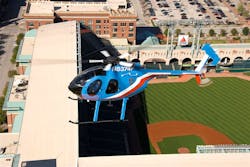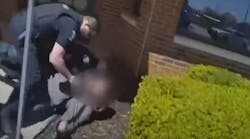Law enforcement agencies in many large cities are equipped not only with the usual ground units, but with air support units as well. Both parties play key roles in each and every situation, especially when it comes to emergencies. Emergency situations call for tight communication and fast resources. Mapping systems that are engaged in many air units aid by providing overlays which provide additional information such as key points, street names, addresses and more. When it comes down to each and every type of situation air support units face, communication is the key to every endeavor. “We always communicate through radio channels,” says Lt. J. D. Waltmon, of Houston Police Department. The Houston Police Department Air Support Division has a few different ways of communicating with other law enforcement personnel. “We also have our own HP Fox channel; that is ours alone. If we are outside of the city limits our communication goes through other law enforcement channels that we have access to,” says Waltmon.
Better mapping through flight (or similar subhed)
One main advantage of having air support divisions is their freedom and open air ability to aid in mapping out routes for both air and ground units. The better the map, the faster units may respond. Motorola Solutions has come up with a few great options when it comes to mapping and technical support for public safety personnel. One of their most efficient forms of communication is their Premiere One Suite, which is part of their CAD system. This particular CAD system has a GPS feature that will track the most direct route to the address a citizen calls in with. According to Karen Carlson, Manager, Product Management, Integrated Command and Control and Records Data Mangenment, this is often used by dispatchers but helps them to route air and ground units with GPS coordinates. Premiere One Suite also allows dispatchers to warn units of potential roadblocks. Once the GPS coordinates are brought about, the current road condition is also seen. Being able to redirect units is key to having them arrive on scene safely and the most efficiently. This aids air support as well by allowing them to find the closest landing pad to the scene. Since air support is able to scope out direct routes or have them already on hand, knowing the best landing area is extremely helpful. “Through this type of technology dispatch is able to give other units a heads up on the best routes possible,” says JoAnn Fodge, PremierOne CAD and Responder Location Product Manager.
In most jurisdictions, there are a few main routes for helicopter units to take, whether it be during a disaster, pursuit or a routine call. For Oklahoma City Police Department mapping out emergency routes comes naturally due to training and the use of AeroComputer Model 8000. “All of our pilots are commercially rated”, says Darla Woodruff, Oklahoma City PD air supervisor. “During their primary flight training, they are instructed on FAA sectionals and how to map a route. In the aircraft, the crew utilizes the AeroComputer Model 8000 mapping system. This system allows the tactical flight officer (TFO) to utilize a map of the city/county streets.”
Training for success [or similar subhed]
In addition, all agencies with air support must implement special training for using the technology aboard the helicopter unit, as well as trainings centered around protocol and procedure. “Our unit has two certified flight instructors,” Woodruff says. “We conduct in-house pilot training every four months; the pilots attend the manufacturer’s recurrent and night emergencies training yearly, and we conduct regular unit meetings to discuss safety and procedures.” Oklahoma City PD also conducts tactical flight officer training each year. “The TFO’s are instructed on FLIR, AeroComputer, searchlight, radio, and LOJACK usage,” Woodruff said. “Search techniques are also taught in the curriculum.” When it comes to emergencies it is often up to the air support as to the direction the route or the situation itself takes. “The pilot is in-charge of the aircraft and has final authority as to whether the crew will respond to a call-for-service,” Woodruff says. “The pilot considers many factors when determining if they will respond to a call-for-service: visibility, winds, precipitation, condition of crew, condition of aircraft, location of call, and type of call.”
Houston Police Department holds their trainings for helicopter pilots two times per year. “We have trained using scenarios that include both our pilots and SWAT team,” says Lt. J. D. Waltman. “The trainings are centered around the aircraft, how to handle different weather and other trends.”
Tapping into video (or similar subhed)
Another line of technology for air units that has recently come about has been brought out by IMT. Their SkyMaster TX transmitter brings air surveillance to a new level. “Our transmitters take video feed from the camera in the flier and transmit it to receivers in ground units,” Business Development Manager, Law Enforcement, Sean Drew of IMT says. “The transmitters use sensors that detect daylight, night vision and thermal as well.” This type of technology allows law enforcement units on the ground a chance to see what is coming up ahead on their current route. The SkyMaster TX is also used in situations such as managing crowds, traffic or for additional information the helicopter unit needs to relay to the ground unit.
The SkyMaster TX may be easily downlinked. “The Air Support transmits video at all times during our flights,” says Mark Foster, Senior Police Officer of Houston Police Department. “Once all equipment is up and running the transmitter is turned on, so essentially all the flight can be seen by personnel that might be monitoring the downlink.” Having video sent to command staff, dispatch and other officers and agencies involved keeps everyone clued in on what is taking place. “They can see everything we are capturing on our flight and on our calls,” Foster said. “We have just a few units with downlink receive capability, but all patrol stations and some specialized divisions have handheld receivers that can be utilized while over their scene.” Devices such as these allow emergency routes to be planned in an effective way. This type of technology also allows air support to alert ground units of upcoming situations and whether or not to back off of a situation or bring in more backup.
Both the SkyMaster TX and the Premier One Suite offer mapping capabilities. Having the ability to map out the best or quickest route possible and being able to share this information immediately with other units, command staff and communication officers provides a great advantage to law enforcement personnel. Not only does this allow for a faster rate for civilian safety but it also allows first responders with a safer way to assess and handle the situation at hand.
Having good, strong communication, the right technology, and a plan is the key to success and safety in every emergency situation. The latest technology has allowed agencies the opportunity to train and network together toward a common goal.
n Watch length (agreed to 1500-2000 words) draft was 1159
n Break up some of the larger paragraphs to add variety and give reader breaks
n Too avoid extra-long quotes (and phrases you could say better yourself) … try paraphrasing here and there
n I thought you did a great job of integrating new technology into the article and explaining what it is and helps law enforcement. Did any of the officers you talked to mention a specific story or anecdote of an emergency situation they responded to? I think it would be nice to weave in a real-use story or example, if possible.
n Asked HR for pics
DRAFT II
Air Support: Handling Crisis
By: Hilary Romig
Law enforcement agencies in many large cities are equipped not only with the usual ground units, but with air support units as well. Both parties play key roles in each and every situation, especially when it comes to emergencies. Emergency situations call for tight communication and fast resources. Mapping systems that are engaged in many air units aid by providing overlays which provide additional information such as key points, street names, addresses and more. When it comes down to each and every type of situation that may occur, air support units face, communication is the key to every endeavor. “We always communicate through radio channels,” says Lt. J. D. Waltmon, of Houston Police Department. The Houston Police Department Air Support Division has a few different ways of communicating with other law enforcement personnel. “We also have our own HP Fox channel; that is ours alone. If we are outside of the city limits our communication goes through other law enforcement channels that we have access to,” says Waltmon.
Efficient Mapping Through Flight
One main advantage of having air support divisions is their freedom and open-air ability to aid in mapping out routes for both air and ground units. The better the map, the faster units may respond. Motorola Solutions has come up with a few great options when it comes to mapping and technical support for public safety personnel. One of their most efficient forms of communication is their Premiere One Suite, which is part of their CAD system. This particular CAD system has a GPS feature that will track the most direct route to the address a citizen calls in with. According to Karen Carlson, Manager, Product Management, Integrated Command and Control and Records Data Management, this is often used by dispatchers but helps them to route air and ground units with GPS coordinates. Premiere One Suite also allows dispatchers to warn units of potential roadblocks. Once the GPS coordinates are brought about, the current road condition is also seen. Being able to redirect units is key to having them arrive on scene safely and the most efficiently. This aids air support as well by allowing them to find the closest landing pad to the scene. Since air support is able to scope out direct routes or have them already on hand, knowing the best landing area is extremely helpful. “Through this type of technology dispatch is able to give other units a heads up on the best routes possible,” says JoAnn Fodge, PremierOne CAD and Responder Location Product Manager.
In most jurisdictions, there are a few main routes for helicopter units to take, whether it be during a disaster, pursuit or a routine call. For Oklahoma City Police Department mapping out emergency routes comes naturally due to training and the use of AeroComputer Model 8000. “All of our pilots are commercially rated”, says Darla Woodruff, Oklahoma City PD air supervisor. “During their primary flight training, they are instructed on FAA sectionals and how to map a route. In the aircraft, the crew utilizes the AeroComputer Model 8000 mapping system. This system allows the tactical flight officer (TFO) to utilize a map of the city/county streets.”
Training for Success
In addition, all agencies with air support must implement special training for using the technology aboard the helicopter unit, as well as trainings centered around protocol and procedure. “Our unit has two certified flight instructors,” Woodruff says. “We conduct in-house pilot training every four months; the pilots attend the manufacturer’s recurrent and night emergencies training yearly, and we conduct regular unit meetings to discuss safety and procedures.” Oklahoma City PD also conducts tactical flight officer training each year. “The FTO’s are instructed on FLIR, AeroComputer, searchlight, radio, and LOJACK usage,” Woodruff said. “Search techniques are also taught in the curriculum.” When it comes to emergencies it is often up to the air support as to the direction the route or the situation itself takes. “The pilot is in-charge of the aircraft and has final authority as to whether the crew will respond to a call-for-service,” Woodruff says. “The pilot considers many factors when determining if they will respond to a call-for-service: visibility, winds, precipitation, condition of crew, condition of aircraft, location of call, and type of call.”
Houston Police Department holds their trainings for helicopter pilots two times per year. “We have trained using scenarios that include both our pilots and SWAT team,” says Lt. J. D. Waltman. “The trainings are centered around the aircraft, how to handle different weather and other trends.” These trends refer to new tactics in policing brought on by recent situations in law enforcement.
Sharing Video Feed
Another line of technology for air units that has recently come about has been brought out by IMT. Their SkyMaster TX transmitter brings air surveillance to a new level. “Our transmitters take video feed from the camera in the flier and transmit it to receivers in ground units,” Business Development Manager, Law Enforcement, Sean Drew of IMT says. “The transmitters use sensors that detect daylight, night vision and thermal as well.” This type of technology allows law enforcement units on the ground a chance to see what is coming up ahead on their current route. The SkyMaster TX is also used in situations such as managing crowds, traffic or for additional information the helicopter unit needs to relay to the ground unit.
The SkyMaster TX may be easily downlinked. “The Air Support transmits video at all times during our flights,” says Mark Foster, Senior Police Officer of Houston Police Department. “Once all equipment is up and running the transmitter is turned on, so essentially all the flight can be seen by personnel that might be monitoring the downlink.” Having video sent to command staff, dispatch and other officers and agencies involved keeps everyone clued in on what is taking place. Once the video footage is downlinked to the receivers, the ground units as well as other staff in the department are able to view everything that is taped during flight. “We have just a few units with downlink receive capability, but all patrol stations and some specialized divisions have handheld receivers.” These handheld devices may be used just as effectively while at a scene. Devices such as these allow emergency routes to be planned in an effective way. This type of technology also allows air support to alert ground units of upcoming situations and whether or not to back off of a situation or bring in more backup.
Stories of Success
Both the SkyMaster TX and the Premier One Suite offer mapping capabilities. Having the ability to map out the best or quickest route possible and being able to share this information immediately with other units, command staff and communication officers provides a great advantage to law enforcement personnel. Not only does this allow for a faster rate for civilian safety but it also allows first responders with a safer way to assess and handle the situation at hand. Drew recalls one particular situation the Houston Police Department encountered involving a car chase. Since the helicopter unit was equipped with the SkyMaster TX, the helicopter pilot was able to downlink live video footage to the units on the ground, which allowed the majors and additional command staff to assess the situation as it happened. The department was able to monitor the situation and make choice decisions on whether to send more units to the situation or to have their officers back off of the situation due to safety.
Another occurrence where technology such as SkyMaster TX helped was an event that happened not soon after the Ferguson riots. “We had protests here in Houston,” relayed Foster. “We provided video to the Command Center and a Chevrolet Tahoe at the site.” By doing this, the Houston Police Department officers were able to show the video to the Chief as well as other staff. This also helped SWAT the team be aware of the current situation as well as determine what needed to be done in the situation. “This gave them a broad idea of what was going on not only at the main protest site, but surrounding areas.” By keeping all of the departments groups in the loop, other crewmembers were able to see what was happening as it happened. This in turn, grants faster response time.
Everyday Use
The use of modern technology has greatly increased the success of public safety operations and communication as a whole. With these devices law enforcement officers are able to provide more efficient and effective service to the public. Live video footage from the air units to the ground units may be used for intense situations such as emergencies, disasters or car chases as well as for everyday traffic needs and management.
Having as well as maintaining good, strong communication, the right technology, and a plan is the key to success and safety in every emergency situation. The latest technology has allowed agencies the opportunity to train and network together toward a common goal.



